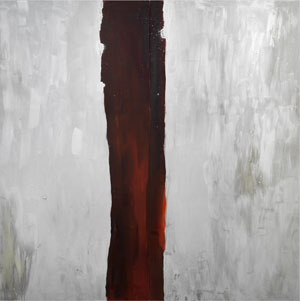8.6.24 — A Child Is Born
A child was born in Gaza after her mother’s death, to an uncertain fate. Soon she, too, lay dead, I read in The New York Times, but what if she had lived, and what is it like to be a child in time of war?
To pick up from last time on New York summer sculpture, the question has become a staple of wartime journalism, with good reason. Articles like this one are crowd-pleasers—poignant, humane, hopeful, a bit of a cliché, and all too close at hand. So, too, is what I came to see, sculpture on the Met roof by Petrit Halilaj through October 27. He treats casualties of war not as numbers, but as budding lives and artists themselves.
Halilaj pictures not them but what they see, and he should know. Born in Kosovo in 1986, he was just five when a decade of Balkan wars began. He spent a year in Kukes II, a refugee camp in Albania, and an inscription along the base of one large work reads Return to Kukes. It is, though, the outlines of his remembered home, now destroyed. Sculpture since David Smith, Alexander Calder, and Gego has often boasted of “drawing in space.” And here a child’s drawing translates easily into slim, jagged lines of bronze and steel.
Halilaj, now based in Berlin, calls the show his Abetare, after an alphabet primer in Albania. On one trip home, he visited a museum of ethnology (a former museum of natural history) that had salvaged classroom desks from the Balkans, and he takes his imagery from what children had drawn or carved there, as children will. This is not just his home, but also theirs. Nor is it just his spider in a second sculpture, with the nasty smirk of a knowing child. Its shadows cling to the Met roof like graffiti, and so do smaller works, like one reading HERE. And here we are.
Other pieces include Batman (alas, not Spiderman), a proclamation that 2 + 2 = 5, a large flower, and a star, in what aspires to a child’s whole universe, but this is not just for children. Batman hangs upside-down like an actual bat, the math could be an act of rebellion or a refugee’s loss of years of school, the house looks near to collapse, and the giant spider owes a debt to Louise Bourgeois. (Her spider in Dia:Beacon was long my laptop’s lock screen.) Nor is the roof altogether suitable for children—not when it serves as a bar during summer. Art in past summers has been more site-specific, like table settings by Adrian Villar Rojas or a curved wall by Héctor Zamora, but Halilaj uses every inch he can. Two pigeons on the roof of the roof might have flown in from Central Park.
It pays to look up, all the more so because the Met has raised hedges atop the roof’s low walls. They add to the summer’s greenery and, just perhaps, public safety, but hide the view. And Halilaj is, at heart, always looking up. An angel poses on his spider, as if looking over its shoulder, and the pigeons could doves of peace. An eye could be a child’s or the ancient Egyptian symbol of prosperity and protection. The tilted house will survive as a work of art.
Still not quite ready to enter Central Park? A bright pink-purple missile defends the park entrance by the Plaza Hotel, as Parabolic Light. Fred Eversley through August 25 stands with the California “Light and Space” artists of the 1960s, like Larry Bell and Doug Wheeler, although he owes his translucent materials to more high-tech materials. Just hope he does not start a world war over who will inherit Minimalism. If he does, I am rooting for the spider. I am also set to leave Manhattan altogether in search of art, and I continue next time with Huma Bhabha in Brooklyn Bridge Park.
Read more, now in a feature-length article on this site.
